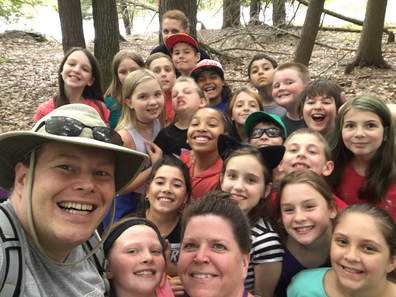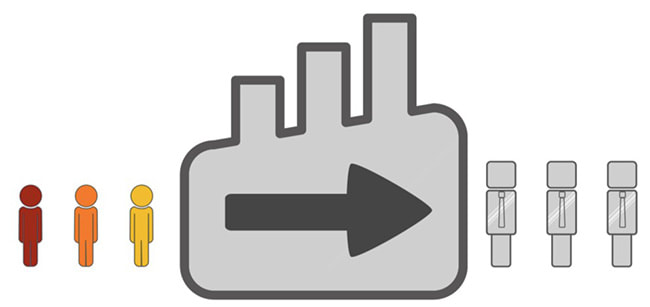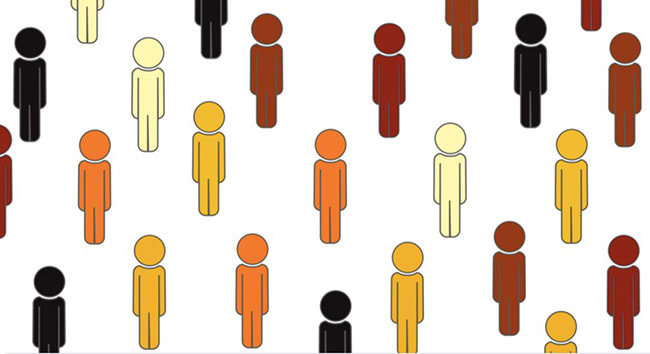|
Blog Post by 2018 Kansas Teacher of the Year Samantha Neill  Last weekend, I sat in bed talking with my husband. Tears ran down my face. I asked him tough questions. "Tell me about an AR-15. What makes it different than the other guns and rifles? What is a bump stock? Do we need large capacity magazines? Is there a need for a gun like an AR-15 in the hands of a common citizen?" I asked him these questions because I need to hear what the other side has to say. I wanted to listen. I wanted to learn. I come from a family of hunters and soldiers. I have my hunter's safety license. I was trained as a child to safely handle guns. I am not scared of them. I would be lying if I said that I didn't already know how I felt about weapons that are commonly used for mass shootings, but I believe in the importance of civil discourse. If I am going to teach it to my students, I am going to practice it at home, at school, at church, and in public. Tonight a family member posted on Facebook wanting to hear from teachers who were willing to be armed. My response was, "Not a chance." I do not typically try to engage in this type of discussion online, but I have a great deal of respect for this family member and saw an opportunity to provide my thoughts on the subject. While I could tell that both of us had different opinions, I felt like I could share my side in a respectful way and she could share hers. Another family member joined the conversation and brought up the fact that we are all concerned about the welfare of our children. That is true. This is one fact in which we can agree. Being prepared to react in a crisis situation is part of my job as a teacher. I walk into a building and see an AED, I take note. I know how to use it, and I may be called upon to do so should someone go into cardiac arrest. When I walk into a store, I look to see where the exit signs are in case I have to use my "teacher voice" to move my children or a crowd to safety. I know how to use an EPIpen. I can check a person's blood sugar. I am CPR/ First Aid certified. I am always watching. I know I have a responsibility in society that does not come with every job. I am always ready to jump in because it is what I do. However, I am not comfortable being armed, in my classroom. I am a teacher. All of the schools in my county follow the protocol put in place by our local law enforcement officers and sheriff's department. This protocol should allow an armed officer to locate and take down an active shooter in a way that does not put more lives at risk. As hard as it is for me to say this, having an armed person on campus would most likely not stop the initial loss of life. I also know that it takes about a minute for the adults in my school to lock down a 600+ person building. This plan is a "reaction" to an active shooter. Right now, all schools have a reactionary plan. Do we need legislation on guns? Yes. We need to have tough conversations on background checks, age requirements, and whether or not certain guns should be accessible to the public. But I feel like we are missing something here. We need to look at both sides of this issue. I spend my days teaching my students to think proactively. I ask them to think about how we can prevent situations from happening and not wait to respond once they do. In the discussion about active shooters, we are missing the what ifs.
0 Comments
Post written by 2018 Pennsylvania Teacher of the Year Michael Soskil  Twenty-one years later, I still remember my first day of teaching and how misguided my perceptions were about the career upon which I was about to embark. Like so many others, I thought that the primary role of the teacher was to deliver information to students. I couldn’t have been more wrong. Now, years later, I have come to understand that being a good teacher is as much about building relationships with students while modeling determination, curiosity, compassion, and helping others through the process of learning. I am constantly learning new things from my students. Here are six things they have taught me. Don’t take yourself too seriously. I don’t think you can be an effective teacher if you aren’t willing to make mistakes in front of your students and laugh at yourself. When I first started teaching I wanted to make sure my students knew I was in control of the classroom. I had great classroom management, but very little classroom empowerment. Now I am much more comfortable allowing my students to see me as a fellow flawed human. There is a culture of respect in my classroom. I respect my students, they respect me, and they respect each other. Within that culture, we understand each of us makes mistakes on occasion, and that they are learning opportunities. Passion is powerful. Years ago, when I was teaching 5th grade, I started shifting my classroom to be more focused on letting students learn through their passions. Instead of everyone reading the same non-fiction text to learn our reading standards, students were able to choose books on topics that interested them. Instead of each student having to write a persuasive essay on a prompt that I gave them, they were able to blog about an issue they cared about and publish it to a global audience. As they were able to discover and pursue their passions, they became more engaged in learning. They also helped me see how important it was to pursue my passions and to use my voice to share them with others. Autonomy is necessary for empowerment. When we find ways to give autonomy to students in the learning process they flourish. I’ve seen this many times in my own classroom, but the example that sticks with me happened during a visit to the HIP Academy in rural western Kenya less than 2 weeks after the school opened. I brought with me some donated tablets and an internet connection. The teachers told me that few of the students had ever seen a screen before I arrived. During my visit I facilitated a Skype call between those children and 2nd grade students in Australia. I told the Kenyan children that they were in charge of teaching the Australians the names of different animals in Swahili. After a few moments of nervousness, the HIP students began to shine with confidence as they picked up stuffed animals and taught their new friends. Being given the chance to be in charge of the call allowed those students to take ownership of the lesson. You can’t change the world if you don’t know much about it. I teach in the small, rural town where I have lived almost my entire life since I was 11 years old. Like all teachers, I want my students to believe that the learning that happens in school matters, and that they can use it to change their world for the better. I have learned to give them opportunities to see beyond our school walls and make a difference in their local and global communities by connecting with community members and using videoconferencing tools like Skype. As a result, my students have taught me how those experiences allow all of us to see ourselves as interconnected like never before. Everybody has the capacity to impact their community for the better. Each time we collaborate with a scientist, astronaut, park ranger, international teacher, or group of students from around the globe, it is a great learning experience for students. So many times those connections have inspired my students to develop ways to make the world a better place. They have designed and fund-raised to build a bridge in Africa so that students could go to school. They have started gardening projects to grow produce for the local food pantry. They have worked to provide clean drinking water for children in the Kibera Slum of Nairobi. They have stopped using plastic straws in the cafeteria in an attempt to save penguins from plastic pollution. Through these student-driven projects and so many others, I have learned that children of any age or background can make their world a better place if given the opportunity. Teaching is the greatest job in the world. Again and again, my students have taught me that there is no better job on the planet than being a teacher. Teaching is an emotional roller-coaster. Because we care about our students so much, we experience the joys of success with them and the pangs of failure. We deal with the anguish when there are situations out of our control that cause our students pain, and we rejoice when we watch them overcome obstacles to reach their potential. But, we get back so much more than we put into it. Each day we are with our students, we have the opportunity to make the world just a little better for each of them. More importantly, we get to teach them how to affect positive change and feel the joy of doing good for others. Over the years, my students have taught me how lucky I am to get the opportunity to love them and to watch them grow. Blog written by Dr. Brian E. McDaniel, 2018 California Teacher of the Year Numerous issues challenge public education, such as closing the achievement gap and helping students out of systemic poverty; however, ensuring every student’s success is the most pressing concern. Low achievers have seemed to fall by the wayside. Many students leave our care feeling under-served, undervalued, and under-prepared for the real world and people who believe they cannot succeed often live up to their own expectations.
Many of our most vulnerable students are goose-stepped out of reaching their potential by being assigned a label. Oftentimes, children accept that they are only as good as the label placed upon them. Carmen was labeled a troublemaker in seventh grade. Because of her profanity laden defiance, she was removed from every class except music. Though she failed all of her classes and was recommended for expulsion three different times, this did not dissuade me from finding her strengths. During a Student Study Team meeting, I highlighted her talent as a natural peer leader with exceptional critical thinking and verbal communication skills. Everyone in the room, including Carmen, was awestruck. That day the road opened for Carmen and she began rising to the high expectations placed on her by one person. Carmen’s eighth grade year was stellar. She stayed out of trouble, was a member of our national championship choir, and earned principal’s honor roll all year. Carmen’s journey could have ended much differently if she had accepted the original label. Actively, we need to focus equally on students who are withering and falling between the cracks. As teachers, we have the power to create success through opportunities. Bronx, a high functioning special needs student, struggled through school and often expressed that he was “just not good at anything.” Though Bronx tried every instrument in the band with no success, I was determined to find his island of competence. Finally, I created a position for him to be our “equipment commander.” He learned how to load and unload music equipment for tours and stage performances. In this position, Bronx was pivotal in the success of the entire music program and coordinated all performance logistics. He developed rapport with every member of the band letting them know he was there to support them, and, during his senior year, mentored younger students to replace him after he was gone. The knowledge and experience he gained during his high school years landed him a job as a stagehand in a performing arts theater in Oregon. If a person has a square peg and a round hole, cut a square hole. Both Bronx and Carmen felt that they were failures. My students are my life, my measurement of success. When my students feel like a failure, then I have failed them. Never should a child leave our classroom feeling less than they arrived. Every day, we need to find new ways for every student to feel success as it only takes one great experience to change the trajectory of a child’s life. Blog written by Luke Wilcox, 2018 Michigan Teacher of the Year The craft beer revolution has taken over the United States. No longer are people flocking towards factory-produced mediocrity. Instead, they are savoring the unique flavors that are being batch produced through innovative brewing processes with interesting ingredients. What can education learn from this whole craft beer movement? Start by thinking of our students as the product of an intentional brewing process. Currently, we are standardizing curriculum, standardizing teaching practices and standardizing assessments, which looks a lot like the factory model for mass producing beer. The product we are trying to produce is a standardized, ready-for-college robot. This may have worked well in our world 50 years ago, but the world has changed. Our world demands a community of diverse and individualized thinkers in order to solve complex issues. And we need to start cultivating these problem-solvers in our classrooms right now … using Craft Education. Here are the top 3 strategies for achieving this outcome: 1. Provide students with choice in their learning. Each individual student has their own interests, passions and struggles. Each has their own motivation for success. Each has their own method for constructing new learning. Providing choice for students allows each to connect with their own natural curiosity and to create their own individual path to understanding.
Using Craft Education, we can create a community of diverse thinkers who are ready to engage in our global world and find solutions to problems that don’t even exist yet. To achieve this diversity of thinking, we must acknowledge and celebrate differences in our students – and to appreciate each student’s unique flavor.
For more details on the idea of Craft Education, see my TEDx talk from University of Michigan-Dearborn. |
Details
Author2018 State Teachers of the Year - Each post will be authored by one of the 2018 STOYs. ArchivesCategories |
 RSS Feed
RSS Feed



